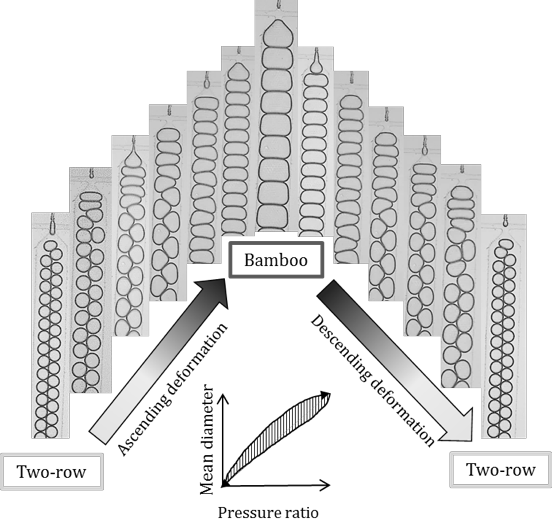Foam hysteretic behaviour
 Aqueous foams are complex fluids that generally behave as non-Newtonian (Höhler and Cohen-Addad, 2005); exhibiting both a solid-like and a liquid-like behaviour depending on the degree of deformation. The foam structure is also time-dependent; behaving like a shear-thinning fluid over time after being subjected to deformation. This hysteretic behaviour plays an important role in foam stability. In rheometry, one of the best alternatives found so far to study this is to perform an oscillatory test within the linear viscoelastic range (Bekkour and Scrivener, 1998, Saint-Jalmes, 2009). However, foams present a very unstable structure which is dependent on destabilising events occurring simultaneously (drainage, coalescence & coarsening). This instability makes foam rheology difficult to study and model. Moreover, the sample is also subjected to aging. One way to avoid aging is to constantly renew the foam, to limit the drainage by neglecting gravity and to generate very monodisperse foam. All this makes microfluidics a very advantageous technique to study foam thixotropy.
Aqueous foams are complex fluids that generally behave as non-Newtonian (Höhler and Cohen-Addad, 2005); exhibiting both a solid-like and a liquid-like behaviour depending on the degree of deformation. The foam structure is also time-dependent; behaving like a shear-thinning fluid over time after being subjected to deformation. This hysteretic behaviour plays an important role in foam stability. In rheometry, one of the best alternatives found so far to study this is to perform an oscillatory test within the linear viscoelastic range (Bekkour and Scrivener, 1998, Saint-Jalmes, 2009). However, foams present a very unstable structure which is dependent on destabilising events occurring simultaneously (drainage, coalescence & coarsening). This instability makes foam rheology difficult to study and model. Moreover, the sample is also subjected to aging. One way to avoid aging is to constantly renew the foam, to limit the drainage by neglecting gravity and to generate very monodisperse foam. All this makes microfluidics a very advantageous technique to study foam thixotropy.
Nowadays, microfluidics is employed to study foams for a wide range of applications, from enhanced oil recovery to biomedical application. The technique we developed aims to study foam hysteretic behaviour in a flow-focusing microfluidic device in the case of Newtonian and non-Newtonian continuous phases. Firstly, a detailed foam regime map was generated by varying the liquid and gas inlet pressures. Secondly, regions were identified where the transition from two-row to bamboo foam pattern was observed. Then, we evaluated the hysteretic behaviour of the foam by introducing the analogous of a standard three-step test in which the recovery of viscosity is commonly studied over three deformation stages. In our case, the 2D foam behaviour is studied over an induced cycle of ascendant and descendant deformation well-controlled by varying the gas pressure for a constant liquid pressure. Thus, the recovery of the two-row foam pattern used as a reference, is studied after a high deformation phase corresponding to the bamboo pattern.
Nanobubbles
In the last two decades, a new kind of bubbles called “nanobubbles” was discovered. These bubbles are starting to be used in a wide range of application from surface cleaning to drug delivery because of their extraordinary stability. This super stability is not yet fully understood but the main theories existing are x and x. These bubbles can be observed in the bulk of an aqueous solution (“bulk nanobubbles”) and are characterised by a diameter ranging from 100 to 300 nm. We investigate the generation of nanobubbles via a custom-designed microfluidic flow-focusing device, and their behaviour in the presence of surfactants.
